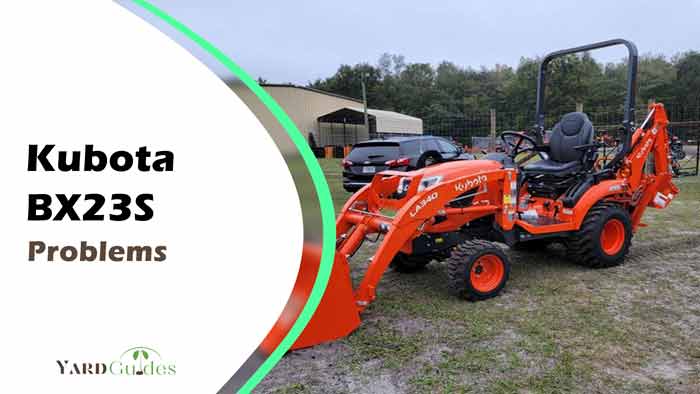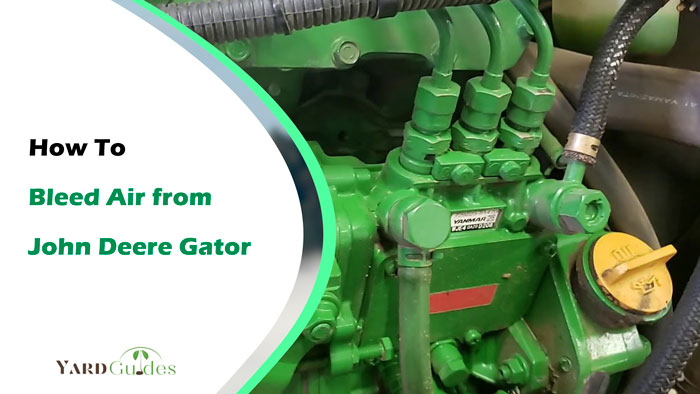Kubota BX23S is a popular sub-compact tractor designed for a variety of applications, including agriculture, construction, and landscaping. While it is known for its reliability and versatility, like any other machine, it may encounter some problems during its operation.
So, what are the most common Kubota BX23S problems? They include issues with the fuel system, such as
- Clogged filters
- Electrical problems, such as battery failure, and starter motor issues.
- BX23S also has hydraulic system problems, such as leaks. These issues can cause the tractor to perform poorly, reduce efficiency, and damage its components.
By reading on, you will learn more about the specific symptoms of these problems, how to troubleshoot them, and how to prevent them from occurring.
Common Challenges With Kubota BX23S And Solutions
Here’s a table with common problems and solutions for the Kubota BX23S.
| Categories of Problems | Solutions |
| Hydraulic system issues | Check the hydraulic fluid level and add more if necessary |
| Engine Challenges | Check for clogged fuel filters and replace them if necessary |
| Check the fuel injectors and clean or replace them if necessary | |
| Transmission issues | Check for loose or damaged linkage and repair as necessary |
| Electrical problems | Check the battery, fuses, loose or corroded connections, charging system, and switches and replace if necessary |
| Steering Difficulties | Check the power steering fluid level and add more if necessary |
In-Depth Discussion of Kubota BX23S Problems And Their Solutions
Here, we have segmented the issues into 5 categories along with the solutions. Let’s break them down side by side.
Category 1: Hydraulic System Issues
The common hydraulic system issues that may arise in the Kubota BX23S.
- Leaks
Hydraulic systems rely on high-pressure fluid to operate, and any leaks can significantly reduce their effectiveness. Leaks can be caused by,
- Damaged hydraulic hoses or fittings
- Worn out hydraulic seals or gaskets
- Loose or improperly tightened connections
- Corrosion or rust on hydraulic components
- Overheating or excessive pressure within the hydraulic system
- Improper maintenance or use of the equipment
Some symptoms of hydraulic leaks include
- Visible oil or fluid leakage around the hydraulic system
- Reduced or loss of hydraulic power or functionality
- Slow or unresponsive movement of hydraulic components
- Unusual noises or vibrations during operation
- Increased fluid consumption or need for frequent refilling
- Low Hydraulic Pressure
It can cause slow or weak operation of hydraulic components. Low fluid levels, a worn hydraulic pump, or a clogged filter may cause it.
- Overheating
Hydraulic systems generate a lot of heat, and the excessive heat can cause damage to components, including seals, hoses, and valves. And overheating can occur due to a low fluid level, a clogged filter, or a malfunctioning hydraulic pump.
- Noise
Unusual noises coming from the hydraulic system can indicate a problem. For example, a whining noise may be caused by a malfunctioning hydraulic pump, while a clunking noise may indicate a problem with the hydraulic cylinder.
Solution
If you notice a hydraulic fluid leak, you should inspect the system thoroughly to locate the source of the leak. Once you’ve identified the location, you can replace the damaged component or repair the leak with a sealant or new fitting
Check out this YouTube video on how to fix hydraulic leaks.
If you notice a decrease in hydraulic pressure, check the fluid level and inspect the filter for any signs of clogging.
To prevent overheating, it’s essential to maintain proper fluid levels, replace filters regularly, and ensure all components function correctly.
Inspect the system for damaged or worn components, such as the pump or motor. Replace any damaged parts and ensure that all components are adequately lubricated.
Category 2: Engine Problems
Some typical engine issues and their solutions include the following
- Engine Stalling
Engine stalling can occur when the engine suddenly shuts off. Various factors, including a dirty fuel filter, a faulty ignition switch, or a malfunctioning fuel pump, can cause this.
- Low Engine Power
It can occur when the engine is not producing enough power to operate the tractor efficiently. Various factors, including a clogged air filter, a dirty fuel injector, or a malfunctioning turbocharger, can cause this.
- Excessive Smoke
Engine burns too much fuel or oil and creates excessive smoke. However, a faulty fuel injector, a damaged piston ring, or a clogged air filter, can cause this burning issue.
Solution
To fix the engine stalling issue, you can replace the fuel filter, check and replace the ignition switch, or the fuel pump.
Replace the air filter, clean or replace the fuel injector, or replace the turbocharger to fix the low engine power issue.
To fix excessive smoke issues, you can replace the fuel injector, piston rings, or air filter. Go over this Youtube video on changing the engine oil and filter.
Category 3: Transmission Issues
Here are some common transmission issues on the Kubota BX23S and their possible solutions.
- Slow or Jerky Gear Shifts
If the BX23S is having difficulty shifting gears, or the gear shifts are slow or jerky, it could indicate a problem with the transmission fluid or the hydraulic system.
- Transmission Slipping
Transmission slipping is where the engine revs, but the tractor doesn’t move. It could be a sign of a worn or damaged clutch or torque converter.
- Transmission Fluid Leaks
If you notice transmission fluid leaking from the BX23S, it could indicate a worn or damaged seal, gasket, or hose.
Solution
For slow, jerky gear shifts,
- Check the transmission fluid level and quality, and replace the fluid if necessary
- If the fluid is fine, it might be necessary to bleed the hydraulic system to ensure it flows smoothly.
In the case of transmission slipping, replacing the clutch or torque converter may be necessary to restore proper transmission functionality.
For transmission fluid leaks,
- Replace the affected component to prevent further fluid loss
- After replacing the worn-out components, top up the transmission fluid at the recommended level
Check out the following YouTube video on how to change the hydrostatic fluid of the transmission.
Category 4: Electrical Issues
Some common electrical issues can occur in the Kubota BX23S, and their possible causes are discussed below.
- Faulty Alternator
The alternator is responsible for charging the battery and powering the electrical system when the engine is running. If the alternator is not working correctly, the battery may not charge properly, and the electrical system may malfunction.
This can cause issues such as dimming headlights, weak signals, and other problems.
- Corroded or Loose Electrical Connections
Electrical connections can become corroded over time due to exposure to moisture and other elements. Loose or corroded connections can cause a range of problems. That includes starting issues, electrical shorts, and other malfunctions.
- Blown Fuses
Fuses are designed to protect the electrical system from overloads and shorts. If a fuse blows, it can cause electrical components to stop working. Blown fuses can occur due to a short circuit, overloading, or other electrical issues.
Solutions
For faulty alternators, check the alternator output voltage with a voltmeter to ensure it functions correctly. If not, replace the alternator.
Check the battery cables for signs of corrosion or looseness and clean or tighten them as needed for the loose electrical connections.
Locate the fuse box and check for any blown fuses. Replace the blown fuse with a new one of the same amperage rating.
Category 5: Steering Difficulties
Here are some common steering issues and their solutions on Kubota BX23S.
- Hard Steering
If the Kubota BX23S is difficult to steer, the first thing to check is the power steering fluid level. Low fluid levels can cause the steering to become stiff. If the fluid level is average, the problem may be with the power steering pump.
- Loose Steering
Loose steering is often caused by worn or damaged tie rod ends, ball joints, or wheel bearings. The tie rod ends connect the steering rack to the steering knuckles, and the ball joints link the steering knuckles to the control arms.
Solution
In the case of hard steering, the pump may need to be replaced.
If any of these components; tie rod ends, ball joints, or wheel bearings are damaged or worn, they should be replaced.
Maintenance Tips
Here are some tips to help prevent or address common issues with the Kubota BX23S.
Check and Change the Engine Oil Regularly
Kubota recommends changing the engine oil and filters every 50 hours of operation or at least once a year. Make sure to use the recommended oil and filter for your BX23S.
Keep the BX23S Clean
A clean machine is less likely to experience problems than a dirty one. Wash the BX23S regularly and remove any dirt, debris, or other contaminants that may accumulate on the machine.
Get more insights from this YouTube video on the maintenance of BX23S.
Conclusion
The Kubota BX23S is a reliable and versatile compact utility tractor that can handle various tasks. However, though it has some common issues, they can be fixed.
If the issues are found, fix them as soon as possible to keep your tractor running smoothly. Also, regular maintenance helps ensure the machine performs reliably and extends its lifespan. These make it a valuable investment for farming, construction, and landscaping applications.



